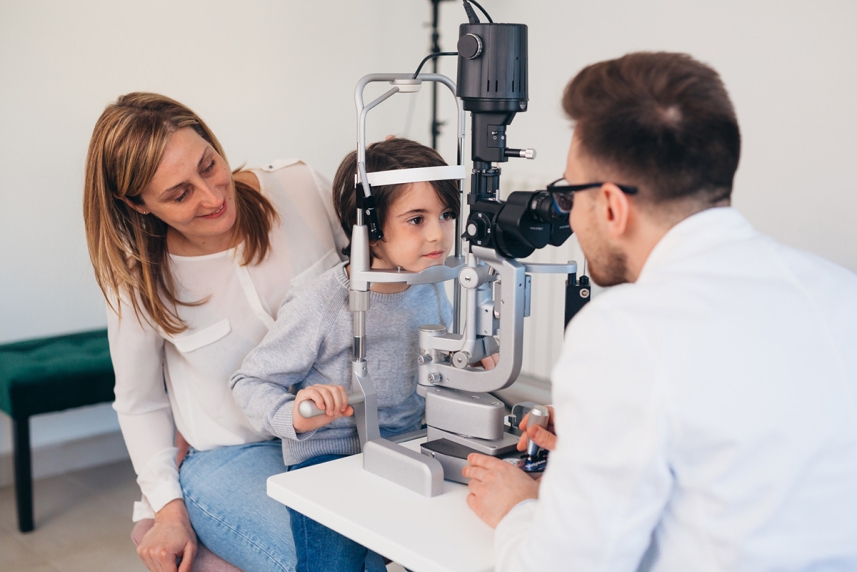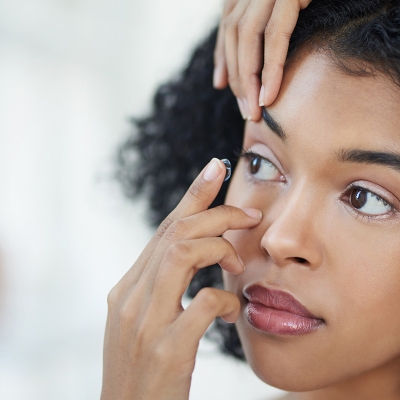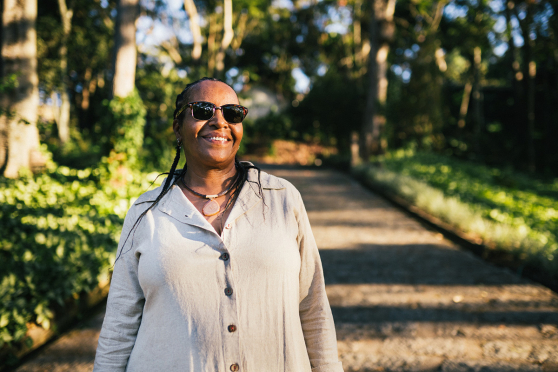Age-by-age guide to eye exams
Find out when it’s a good idea for kids and adults to get their eyes checked and how often.

It’s a good idea for people to get regular eye exams at all ages. It's a way for eye care providers to track any vision problems and find them early. Eye care providers can also keep an eye on people as they get older and their vision changes.
But everybody’s vision needs are different. For example, kids’ vision changes often require more regular checkups. On the other hand, eye care providers may be looking for common eye conditions in adults, ones they need to keep an eye on.
Learn more about eye care providers’ age-specific recommendations for eye exams. Plus, how certain risk factors can increase the need for exams.
Eye care providers in the UnitedHealthcare Vision Network can keep people of all ages’ vision healthy. Search for network providers now.
What is a comprehensive eye exam?
A comprehensive eye exam is a thorough evaluation of a person’s vision and eye health. It can include:1,2,3
- A review of a person’s vision history can check on any current vision or health issues that affect their eyes. An eye care provider may ask a person about when vision symptoms started or whether they’re taking new medications. They can also ask about specific work situations that might be affecting their vision. That could include jobs where someone looks at a computer screen all day, for example.
- Preliminary tests can check for things like:
- Color vision
- Depth perception (ability to perceive distance between objects)
- Eye muscle movements
- How the pupils (colored parts of the eye) respond to light.
- Peripheral (side) vision
- Visual acuity test measures how well a person can see at various distances.
- Keratometry/topography tests measure the curvature of the cornea, the outer layer of the eye.
- Refraction test determines if a person needs glasses or contact lenses. It also gets them the prescription they need.
- Eye movement and alignment test checks how well the eyes work together.
- Slit lamp exam uses a powerful microscope to look at the front part of a person’s eye.
- Retinal exam checks the back of the eye, including:
- Optic nerve (connects the eyes to the brain)
- Retina (light-sensitive tissue at the back of the eye)
- Glaucoma screening test measures eye pressure and checks health of the optic nerve.
People may have more tests done during a comprehensive eye exam.
How often should children get an eye exam?
How often and when a child gets an eye exam depends greatly on their age and risk factors. According to the American Optometric Association (AOA), here’s the breakdown by age and risk factors:1
Birth through 2 years old
- If they’re low risk, they’ll need exams at 6 to 12 months.
- If they’re at-risk, they’ll need exams at 6 to 12 months, or as recommended by their eye care provider.
Ages 3–5
- If they’re low risk, at least once between 3–5 years of age.
- If they’re at-risk, at least once between 3–5 years of age, or as recommended by their eye care provider.
Ages 6–17
- If they’re low risk, before first grade and annually afterward.
- If they're at risk, before first grade and every year after that — or as their eye doctor suggests.
Factors that could put a child at risk of future eye issues could include things like:
- Eyes don’t properly align (strabismus)
- Family history of eye conditions, like nearsightedness (myopia), lazy eye (amblyopia) and others
- Health conditions that can affect the eye
- Mother has an infection during pregnancy
- Prematurity, low birth weight, prolonged supplemental oxygen at birth
- Smoking during pregnancy
- Vision in only one eye
- Wearing contact lenses (kids)
It’s a good idea for parents to talk to their child’s eye care provider or pediatrician about any of these things. This may mean a child will need to see an eye care provider more often.
What are some common eye conditions providers check for in children?
While children can experience a range of vision issues, these are some of the most common:4
- Farsightedness (hyperopia) makes it hard for kids to see things up close.
- Nearsightedness (myopia) makes it hard for kids to see at a distance.
It’s a good idea for parents to ask their child if they may be having trouble seeing at school. That could be reading what their teacher is writing on the board or reading a textbook. These could be signs that they could have one of these conditions.
How often should adults get an eye exam?
How often adults see their eye care provider can be based on age, risk level, race and other factors. Plus, eye care providers may be on the lookout for common eye conditions.
These may need further treatment. Eye care providers will likely want to check up on them more often, depending on how serious they are.
According to the AOA, here’s the breakdown by age and risk factors:
Ages 18–39
- If they’re at low risk, they’ll need to see an eye care provider at least every 2 years.
- If they’re at risk, they’ll need to see an eye care provider at least annually, or more as recommended.
Ages 40–64
- If they’re at low risk, they’ll need to see an eye care provider at least every 2 years.
- If they’re at risk, they’ll need to see an eye care provider at least annually, or more as recommended.
Ages 65+
- If they’re at low risk, they’ll need to see an eye care provider annually.
- If they’re at risk, they’ll need to see an eye care provider at least annually, or more as recommended.
What puts adults at greater risk could include:
- Belonging to certain racial or ethnic groups
- Certain medications that have eye-related side effects
- Eye surgery or previous eye injury
- Family or personal history of eye disease
- Other long-term health conditions that could affect the eyes, like diabetes
- Type of job that can strain vision or can put vision in harm’s way
- Vision in only one eye
- Wearing contact lenses
If a person has any of these risk factors, they’ll want to talk to their eye care provider. They may recommend scheduling eye exams more regularly.
Additionally, adults who have had LASIK or other vision-correction surgeries will want to have an eye exam every 1–2 years to check up on their eye health.
What are some common eye conditions providers check for in adults?
Eye care providers will be checking people 40 and older for certain long-term eye conditions. These can include:5
- Cataracts, a common condition that causes cloudiness in the lens of the eye.
- Diabetic retinopathy, a type of condition caused by high blood sugar. It’s the leading cause of blindness in adults.
- Glaucoma, a group of eye diseases that often has no early symptoms and can lead to vision loss.
How can a person get a comprehensive eye exam?
Anyone can get a comprehensive eye exam. But having vision insurance can make these exams easier to get and cheaper.
For example, people with UnitedHealthcare Vision insurance may get an annual eye exam fully covered, with just a copay.
Here are some simple steps a person can follow once they have vision insurance:
- Search for and find an eye care provider in the UnitedHealthcare Vision Network.
- Check their plan to make sure they know what it covers and how much they may have to pay out of pocket for vision services.
- Schedule an appointment with the eye care provider.
- Prepare for the exam by bringing:
- Current glasses and/or contact lenses
- List of medications they’re taking
- Relevant medical/family history
Looking for a new eye care provider? Search the UnitedHealthcare Vision Network today.
Sources:
- Comprehensive eye exams American Optometric Association.
- Slit lamp examination Kaiser Permanente, last reviewed July 2024.
- What to expect during a comprehensive eye exam All About Vision, last reviewed November 2024.
- Eye exams for children Optometrists Network
- Get an eye disease screening at 40 American Academy of Ophthalmology, April 2024.


